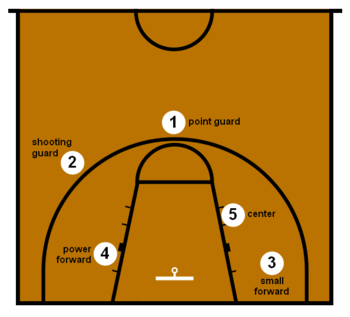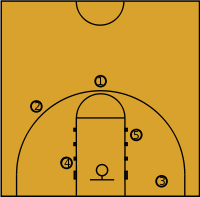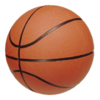Basketball positions

- 1–Point guard
- 2–Shooting guard
- 3–Small forward
- 4–Power forward
- 5–Center
In basketball, there are five players on court per team, each assigned to positions. Historically, these players have been assigned to positions defined by the role they play on the court, from a strategic point of view. The three main positions are guard, forward, and center, with the standard team featuring two guards, two forwards, and a center. Over time, as more specialized roles developed, each of the guards and forwards came to be differentiated, and today each of the five positions is known by a unique name and number: point guard (PG) or 1, the shooting guard (SG) or 2, the small forward (SF) or 3, the power forward (PF) or 4, and the center (C) or 5 "post position".
Guards
[edit]In the early times of the sport, there was a "running guard" who brought the ball up the court and passed or attacked the basket, like a point or combo guard. There was also a "stationary guard" who made long shots and hung back on defense effectively cherry picking before there was the rule of backcourt violations.[1]
Point guard
[edit]The point guard (PG),[2] also known as the one, is typically the team's shortest player and best ball handler and passer. They usually are very fast and are good at driving and short-range shots. Therefore, they often lead their team in assists and are able to create shots for themselves and their teammates. They are able to hit shots outside the key but a majority are inside the 3-point line or layups, largely depending on the player's skill level. Good point guards increase team efficiency and generally have a high number of assists. They are often referred to as dribblers or playmakers. In the NBA, point guards are mostly between 5 feet 10 inches (1.78 m) and 6 feet 4 inches (1.93 m).[3][4]
Point guards are required to do many things in the game of basketball that are very different from the other four positions on the court. While the other 4 positions are mainly focused on putting the ball in the hoop, the point guard must have a different, more team focused mentality.[5] There are usually two types of point guards: a scoring point guard (also known as a lead guard) and a facilitator-type point guard. A scoring point guard regularly has the ability to shoot from three-point or mid-range distance. This type of point guard could also score around the basket with floaters, acrobatic layups or dunks. Stephen Curry (NBA) and Damian Lillard (NBA) are some examples of a scoring point guard. A facilitator-type point guard often has a high basketball IQ, or intuitive understanding of the game, and can see plays happening before they occur. In addition, these types of point guards are typically masters of the half court set offense, and they typically know the correct spots for each player on the court. Another name for this type of player could be 'Coach on the Floor'. Chris Paul (NBA) and Chelsea Gray (WNBA) are examples of a facilitator-type point guard.[6]
Shooting guard
[edit]The shooting guard (SG)—also known as the two or the off guard—is, along with the small forward, often referred to as a wing because of its use in common positioning tactics. As the name suggests, most shooting guards are prolific from three-point range and long mid-range. Before they can get the ball to make the shot, they must work to stay free while others pass the ball around. Their ability to correctly space the floor and find open space for themselves is a key aspect of this position. Just like all positions in basketball, the ability to communicate efficiently with teammates is of great importance. If teammates do not know when or where a player will be open, they won't be able to deliver the ball when an opportunity presents itself. Most of these skills depend on whether the shooting guard is a good shooter, a finisher around the rim, a defender, or different combinations of these.[7]
Throughout the evolution of the game, there have been different types of shooting guards, mainly categorized as offensive threats and defensive guards. Shooting guards usually know their play style and get better at the qualities they are good at and then teams determine their role on the court.[7] If the shooting guard focuses more on taking perimeter jump shots, especially three-pointers, by the use of basketball screens such as down screens, and without much dribbling involved, then the shooting guard is typically known as a catch-and-shoot type of player; Devin Booker would fit this type of play style. If the shooting guard emphasizes driving into the lane and scoring at (or around) the basket, then the shooting guard is generally referred to as a slasher type of player. Dwyane Wade and Michael Jordan were well known for their ability to slash into the lane and score around the rim. However, they also took their fair share of mid-range jump shots and three-pointers.[6] These are known as offensive threats.
If the shooting guard's main priority is to limit or prevent the opposing team's star player (which is usually another shooting guard or other perimeter player), then the shooting guard could be known as a defensive specialist. Tony Allen would be considered a defensive specialist. Shooting guards with the ability to shoot from the perimeter while limiting the scoring opportunities of the other team's best perimeter player can be referred to as the 3-and-D type of players. Danny Green is an example of a 3-and-D type of shooting guard.[6] These are known as defensive guards.
In the NBA, a shooting guard is generally between 6 feet 2 inches (1.88 m) to 6 feet 7 inches (2 m).
Forwards
[edit]Small forward
[edit]The small forward (SF), also known as the three, is considered to be the most versatile of the main five basketball positions. Versatility is key for small forwards due to the nature of their role, which resembles that of a shooting guard more often than that of a power forward. This is why the small forward and shooting guard positions are often used interchangeably and referred to as wings. This position is like the "Swiss army knife" because they can do just about everything, from scoring, rebounding, handling the ball, passing, and the ability to defend, if they are a skilled small forward. They are similar to all-rounders in cricket.[8]
Small forwards have a variety of assets, such as quickness and strength inside. A common thread among small forwards is an ability to "get to the line" and draw fouls by aggressively attempting (posting-up) plays, layups, or slam dunks. As such, accurate foul shooting is also a common skill for small forwards, many of whom record a large portion of their points from the foul line. Besides being able to drive to the basket, they are also good shooters from long range. They are the second-best 3-point shooters on the court along with the shooting guard and usually when remaining stationary, they linger just inside the 3-point line. Some small forwards have good passing skills, allowing them to assume point guard responsibilities as point forwards. Small forwards should be able to do a little bit of everything on the court, typically playing roles such as swingmen and defensive specialists. A small forward under 6 feet 5 inches (1.96 m) might play the shooting guard position some of the time while a small forward taller than 6 feet 7 inches (2.01 m) might play power forward some of the time. In the NBA, small forwards usually range from 6 feet 4 inches (1.93 m) to 6 feet 9 inches (2.06 m). Larry Bird and LeBron James are usually regarded as 2 of the best players to ever play at the small forward spot in the NBA.[9][10]
Power forward
[edit]The power forward (PF), also known as the four, often plays a role similar to that of the center, down in the "post" or "low blocks". The power forward is often the team's most powerful and dependable scorer, being able to score close to the basket while also being able to shoot mid-range jump shots from 10 to 15 feet from the basket. Power forwards are also very crafty and have to be versatile on both offense and defense, but not as much as a small forward. Power forwards usually have good footwork in the paint and can force players into bad shots or blocking shots when guarding the paint.[11] Some power forwards have become known as stretch fours, since extending their shooting range to three-pointers. On defense, they are required to have the strength to guard bigger players close to the basket and to have the athleticism to guard quick players away from the basket. Most power forwards tend to be more versatile than centers since they can be part of plays and are not always in the low block. A tall power forward over 6 feet 8 inches (2.03 m) can be a forward-center, playing PF and C. A smaller power forward, approximately 6 feet 7 inches (2.01 m), can play combo forward, playing SF part-time. In the NBA, power forwards usually range from 6 feet 7 inches (2.01 m) to 7 feet 0 inches (2.13 m).[12]
The power forward is essentially a bigger and stronger version of the small forward but not generally as tall or as long as the center. Generally speaking, the power forward is usually good at rebounding and in some instances, a power forward with a high basketball IQ could also be a great passer, particularly from the high or low post areas via post-split action. Giannis Antetokounmpo or Dirk Nowitzki are notable examples of power forwards in the NBA.[6] In the WNBA, some notable examples of power forwards are Breanna Stewart, Nneka Ogwumike, and Tina Charles.[13] Instead of a physical power forward, the stretch four is known primarily for shooting three-pointers and midrange jump shots instead of post play. The stretch four could also be very useful as a pick-and-pop screener, especially against the drop coverage defensive technique. For example, if stretch four pops to the perimeter after setting a screen, then their defender will most likely not have enough time to close and contest the potential open jump shot if the defender executes drop coverage.[6] Even if the power forward cannot shoot, being a screener can also set up a mismatch for them or their teammates to try to score on the other team's big man if they switch.[11]
Center
[edit]The center (C)— also known as the five, the pivot, or the big; typically plays near the baseline or close to the basket (the "low post"). They are usually the tallest players on the floor. Centers usually score "down low", or "in the paint" (near the basket, in the key), but there have been many centers who are good perimeter shooters as well. They are typically skilled at pulling down rebounds, contesting shots, and setting screens on players. The goal of centers is to create possessions, and, therefore, opportunities to score, by rebounding and trying to stop the other team from scoring in the paint.[14] Because of a center's central role in defense, "shots blocked" is an exciting stat that they, and sometimes other positions, bring to the game.
In the past, players who played the center position were relatively slow and hung out at the basket but were much taller than every other player. Today, however, that generality has changed; now, players who play as a center can also be classified as power forwards, dominate opponents with their defensive skills, and switch things up and shoot from the high post. This has been due to the scarcity of players possessing great skill, ideal height, and durability. The development of more fast-paced and athletic basketball play, which calls for less traditional center play and a more up-and-down-the-court play style, has also contributed to the shift over time. In the NBA, they are usually over 6 feet 8 inches (2.03 m) tall.[15] Some current, notable NBA centers include Nikola Jokić, Joel Embiid, Anthony Davis, and Rudy Gobert.[16]
The presence of a center who can score in the low post (the area closest to the basket) helps to create balance within an offense. Especially if the big man has the footwork to do moves like drop steps, pivots, etc. it can open up the game for their teammates.[14] If it becomes too easy to score from the low post, the center will get double-teamed. This creates an opportunity for open shots by perimeter players as the center will "kick it out", or pass it, to an open perimeter or "wing" player. As perimeter players typically shoot better from long range, this, in turn, may create easier opportunities for a center to score, since defenses often play out closer to the perimeter shooters.[17]
See also
[edit]References
[edit]- ^ Peterson, Robert W. (2002). Cages to Jump Shots: Pro Basketball's Early Years. University of Nebraska Press. pp. 84–. ISBN 0-8032-8772-0.
- ^ ^ a b Rose, Lee H. (2016). The Basketball Handbook. Point guards pass the ball on offence and then head down the floor to set up and start the play. On defense, they guard the other point guard for one of the wings. Once they receive the ball they run towards the basket if it is open. If not open, they stand back and wait till all of their team's layers are down the floor and pass the ball. If open for a shot they will shoot to score a few points depending on where they are standing. Human Kinetics.
- ^ "Average Measurements for NBA Point Guards, 2016". FanSided. Retrieved 2021-04-17.
- ^ "Average Measurements for NBA Point Guards". BasketballScan. Retrieved 2022-01-27.
- ^ "The 8 Must-Have Requirements of Every Point Guard". www.basketballforcoaches.com. 5 December 2012.
- ^ a b c d e "Basketball Positions : Simple Explanation of Basic Concepts". Hoop Student. Retrieved 2021-12-01.
- ^ a b "What Does a Shooting Guard Do In Basketball?". Hoops Addict. 2020-05-08. Retrieved 2023-02-28.
- ^ "Basketball Positions: Key Roles and Responsibilities (explained)". www.basketballforcoaches.com. 2018-02-26. Retrieved 2023-02-28.
- ^ "Average Measurements for NBA Small Forwards, 2016". FanSided. Retrieved 2021-04-17.
- ^ "Voepel: WNBA's top five small forwards". ESPN.com. 2013-07-08. Retrieved 2024-03-03.
- ^ a b "How to Play Power Forward in Basketball". Hoops Addict. 2020-12-13. Retrieved 2023-02-28.
- ^ "Average Measurements for NBA Power Forwards, 2021". FanSided. Archived from the original on 2019-02-19. Retrieved 2019-02-18.
- ^ "Who are the top five power forwards in the WNBA?". ESPN.com. 2018-06-28. Retrieved 2024-03-03.
- ^ a b "How to Play Center in Basketball". Hoops Addict. 2020-12-11. Retrieved 2023-02-28.
- ^ "Average Measurements for NBA Centers, 2016". FanSided. Retrieved 2021-04-17.
- ^ Noh, Stephen (2023-10-13). "Top NBA centers for 2023-24: Ranking all 30 starters from Nikola Jokic, Joel Embiid to Anthony Davis". Sporting News. Retrieved 2024-03-03.
- ^ "The Perimeter in Basketball: Explanation of Basic Concepts". Hoop Student. Retrieved 2024-03-03.


